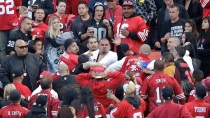Folks attend live sporting events to see the best players in the world do what fans could only dream of doing. They go to leave their real lives for a few hours. They go to be a part of something of which they are not really a part. Most importantly, they do not go to the games wondering if they will leave in an ambulance.
Yet, last week we saw once again a case of a fan dying at a professional sporting event. Whether or not the blame for his death falls at the feet of the stadium or the carelessness of the fan itself is still unclear, but what is clear is that pro sports teams have a question to ask themselves: are our stadiums safe enough for fans?
First, let’s examine the sport with the most games per season, baseball. Fans attend baseball games with full knowledge that stray foul balls will end up in the stands, and there is an inherent risk of being hit. However, fans are unable to sue teams if they are hit by a flying ball because entering the stadium acts as a sort of waiver, and stadium public address announcers at every stadium gives a pregame warning about flying balls to all of the fans in attendance. Even though the teams take these extensive legal precautions, injuries to fans are exceptionally rare by these circumstances. Each year, around fifty to one hundred fans go home with bumps and bruises from flying bats and balls, and seeing as anywhere from 15,000-40,000 fans attend 162 games of 30 teams, the percentages are pretty low. Also, there has only been one reported fan death from flying balls in the long history of major league baseball, and only five such cases in American professional baseball altogether. So the risk that one would expect from attending a game is not all that high.
However, like we saw in San Francisco, fan deaths from falling are a little more common. A few years ago, a father attending a game with his son tried to catch a ball that had been tossed into the stands. He leaned out too far and tumbled twenty feet, landing on his head. He later died from his injuries. There are other stories from around the country of fans tumbling over railings due to carelessness, drunkenness, or reaching for a stray ball. Only a few have resulted in deaths, but all have resulted in serious injury.
There has also been an increase in injury and death as a result of unruly fans. The recent case of greatest note is two years ago when Los Angeles Dodgers fans took to beating a San Francisco Giants fan named Bryan Stow after the two teams’ season opener. The beating put Stow in critical condition and eventually a medically induced coma. This brings up the issue of fan behavior at professional sporting events, as fans in the heat of the moment have a hard time distinguishing an opposing player or fan from a real life enemy. Fans like these are parents’ worst nightmare, as these fans have no problem shouting obscenities at kids attending games if they are wearing the opposing teams’ colors.
Though teams can take all the action they want to help provide better railings to prevent falls and more nets to prevent injury from flying balls, the issue with overzealous fans is more difficult. In the Stow case, he is currently suing the Dodgers organization for compensation over what their fans did. The Dodgers as an organization are not represented by the actions of their fans, but the burden does still legally fall on their shoulders. So the question becomes what can organizations do to prevent cases like Bryan Stow’s? The obvious answer is increased security, but how far can that go to protect 50,000 fans?
The Seattle Seahawks this past week took initiative to lock down on harassment by its fans by dressing some of its security staff in the apparel of the opposing team. No reports have come out yet on whether or not the tactic was effective in terms of arrests, but the concept seems as good of an idea as any. If fans have it in the back of their mind that the person in the enemy’s gear could be a security guard, it will at least force them to consider their actions.
This unfortunately will not work in all cases, and the main reason for this is alcohol. Beer is sold at every professional sporting event in the United States, and not everyone drinks responsibly. The man who fell to his death in San Francisco was reportedly stumbling around drunk, which led to his carelessness, which led to his fall. Many of the fans who berate and abuse other fans have been over-served. Limits are put on alcohol sales: baseball stadiums stop serving beer in the seventh inning; football stadiums stop selling after the third quarter. Some teams, such as the Green Bay Packers, are pulling back even further on sales, as the stop selling at the start of the third quarter rather than the end of it. However, fans who strongly desire to be intoxicated still manage to down as many as they can in less time.
Can stadiums really be blamed for fan deaths at sporting events? They can limit alcohol all they want, but beyond totally drying up the venue, drunkenness will still happen. They can check the guardrails to prevent falls, but idiots will still lose track of where they are. Though teams continue to be legally liable for fan injuries, it is time to stop passing the buck. Fans must be responsible for their own well-being within stadiums just like they are in every other walk of life. No matter how much of an escape it can appear to be, sporting events still take place within the real world.
Photo courtesy of:
http://img.gawkerassets.com/img/18j4vmkzwkzfyjpg/original.jpg

